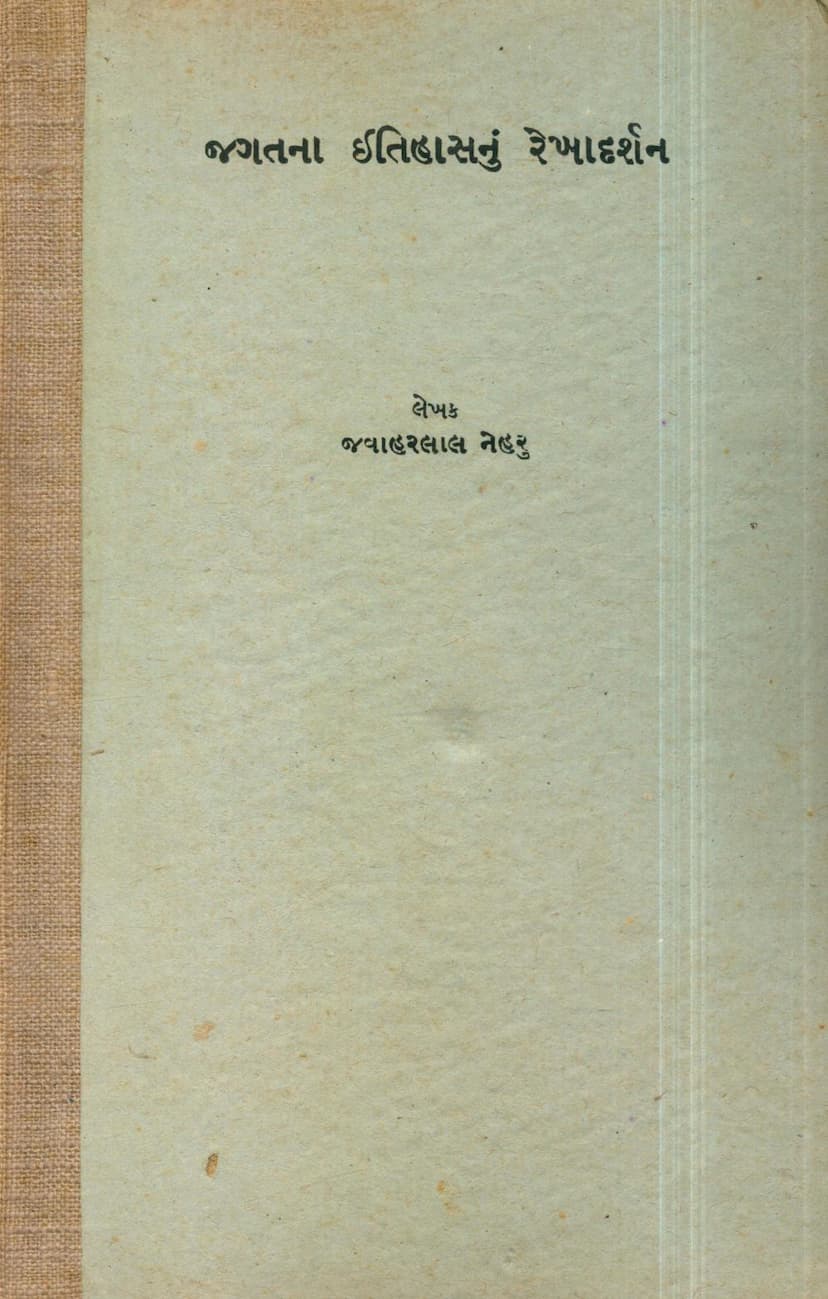Jagatna Itihasnu Rekha Darshan Part 01
Added to library: September 1, 2025

Summary
This comprehensive summary covers the key aspects of the Jain text "Jagatna Itihasnu Rekha Darshan Part 01" by Jawaharlal Nehru, translated by Manibhai B. Desai and published by Navjivan Prakashan Mandir. The catalog link provided is https://jainqq.org/explore/032708/1. The summary draws from the provided pages of the Gujarati text, detailing the book's content and context.
Book Title: Jagatna Itihasnu Rekha Darshan Part 01 (A Glimpse into the History of the World, Part 01) Author: Jawaharlal Nehru Translator: Manibhai B. Desai Publisher: Navjivan Prakashan Mandir First Edition: January 1945, 2,500 copies
Overview:
This book is the first part of a Gujarati translation of Jawaharlal Nehru's seminal work, "Glimpses of World History." Originally written as a series of letters from prison to his daughter, Indira, the book provides a sweeping narrative of world history from its beginnings up to the time of Napoleon's demise. The translator, Manibhai B. Desai, notes the book's initial publication and the delay in its Gujarati translation due to the government confiscating the printing press in 1942. The publisher's note expresses joy at finally being able to release the first volume and recommends reading "Indu ne Patra" (Letters to Indu) as a prelude to this book.
Key Themes and Content:
The book presents a father's perspective on world history, aiming to educate his daughter about the vast sweep of human civilization. Nehru's writing style is characterized by its simplicity and clarity, making complex historical events accessible even to younger readers while maintaining a depth of intellectual rigor. The translation aims to capture the essence and flow of Nehru's original work, making it engaging and informative for Gujarati readers.
Content Breakdown of the Provided Pages:
The provided pages cover the initial sections of the book, including:
- Publisher's Note: Explains the background of the translation, its delay, and the scope of the first volume.
- Introduction (Aamukh): Written by Krishnan Menon, this section highlights Nehru's motivation for writing the book while in prison, the personal nature of the letters to his daughter, and the book's unique blend of historical narrative with personal reflections. It also touches upon Nehru's engagement with contemporary global events and his ability to combine activism with philosophical insight.
- Foreword to the Original Edition (Mul Avrutti ni Prastavna): Written by Jawaharlal Nehru himself on January 1, 1934, this foreword details the genesis of the letters. He explains how the book started as simple explanations of the world's beginnings for his ten-year-old daughter and evolved into a comprehensive historical account due to the "leisure" and "detachment" afforded by his imprisonment. He acknowledges the limitations of writing without access to extensive libraries but mentions his reliance on his extensive notes. He also reflects on the personal nature of the letters and how his perspective on history evolved during the writing process.
- Table of Contents (Anukramanika): This extensive list of chapter titles reveals the chronological and thematic progression of the history covered in the book. The first volume, as stated in the publisher's note, covers world history up to the death of Napoleon, roughly half of the entire work. The chapter titles span from ancient civilizations, Greece, Asian empires, ancient India, China, religious movements in the 6th century BCE, the rise of Islam, the medieval period in India, the development of European societies, the Mongol Empire, the Renaissance, the Protestant Reformation, the Glorious Revolution in England, the Mughal Empire in India, and concludes with the Napoleonic era. The sheer breadth of topics covered is remarkable.
- Early Chapters (Vargathne Divese, Nava Varshni Bhet, Itihasne Bohd, Inkilaab Zindabad, Asia ane Europe, Prachin Sanskrutio ane Aapne Varsho, Greece na Helen Lok, Greece na Nagrra, Pashchim Asia na Samrajyo, Juni Parampara na Bandhan, Prachin Hind nu Gram Swarajya, China na Itihas na Ek Hazar Varsha, Bhutkal ne Saad): These initial chapters lay the groundwork for Nehru's historical narrative. They delve into fundamental concepts of history, the early interactions between Asia and Europe, the emergence of ancient civilizations, and the specific histories of Greece and Persia. They also touch upon foundational aspects of Indian history like village governance and early cultural exchanges. Chapters like "Vargathne Divese" (On the Anniversary Day) and "Nava Varshni Bhet" (New Year's Gift) showcase the personal context of the letters, often linking historical narratives to contemporary events and personal sentiments, especially concerning his daughter Indira and the Indian independence movement.
Jain Context:
While the book is a general history of the world and not specifically a Jain text, the catalog link points to "jainqq.org." This might indicate that this particular collection or archival effort within the Jain community has digitized and cataloged this important historical work. However, the content itself, as indicated by the chapter titles and Nehru's known work, is a broad historical survey. The inclusion of the Jain catalog link might be for archival purposes or as part of a larger collection of intellectual works valued by the Jain community for their educational and historical significance. There is no direct indication within the provided pages that the book itself focuses on Jainism.
Overall Impression:
The provided pages offer a compelling glimpse into Jawaharlal Nehru's ambitious project of making world history accessible and engaging. The personal touch of letters to his daughter, combined with his vast knowledge and insightful analysis, makes this work a valuable resource for understanding not just history but also the mind of one of modern India's most important leaders. The sheer scope and depth of the planned work, as revealed by the table of contents, promise a rich and comprehensive historical journey.